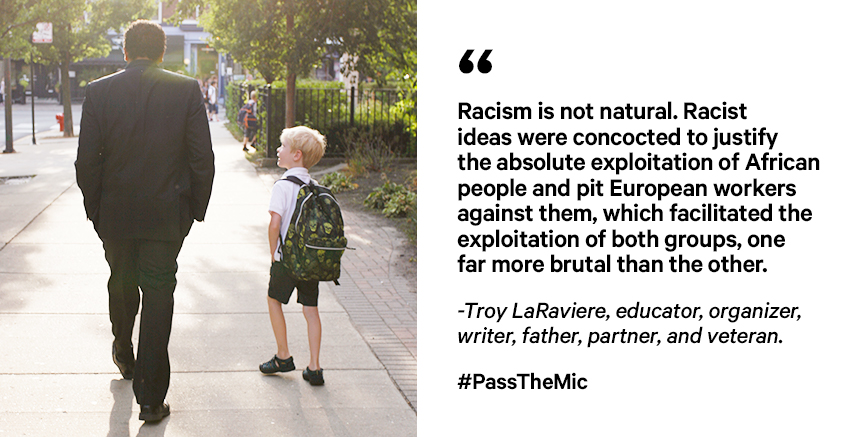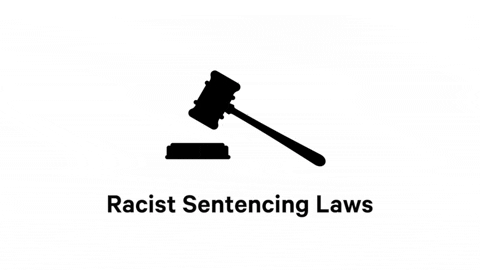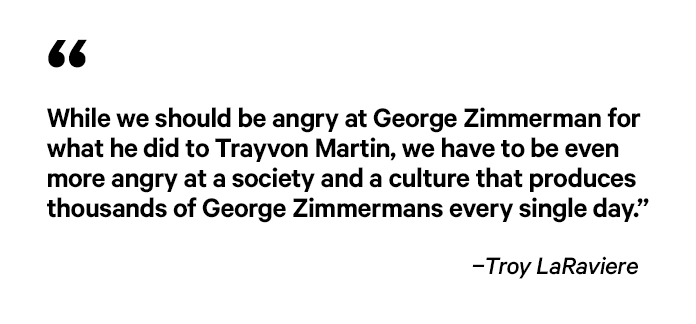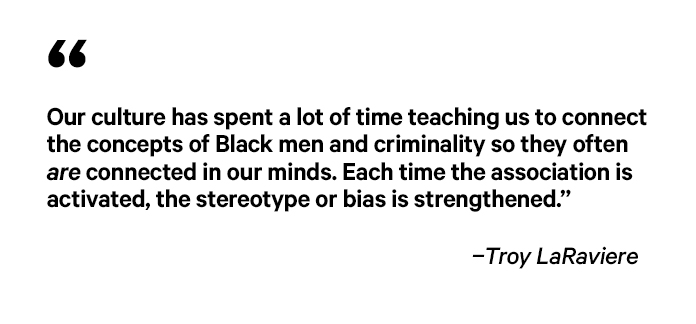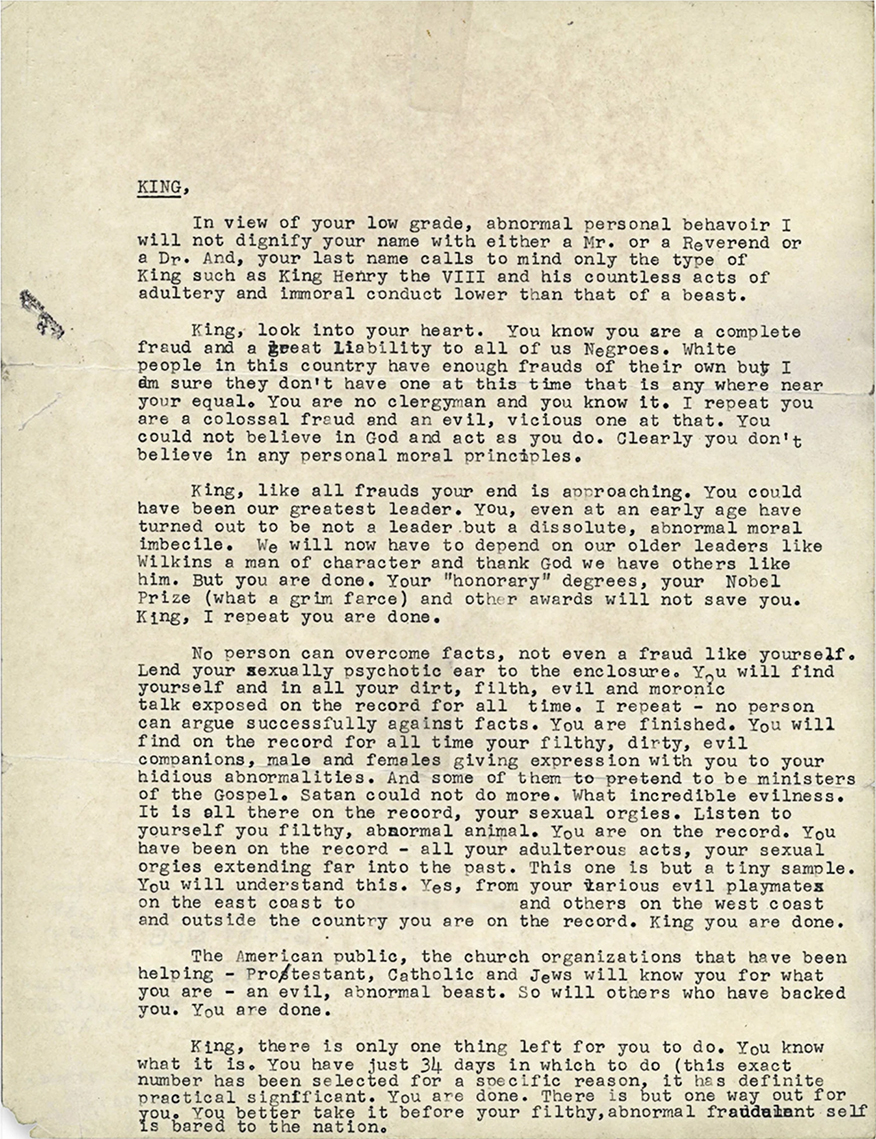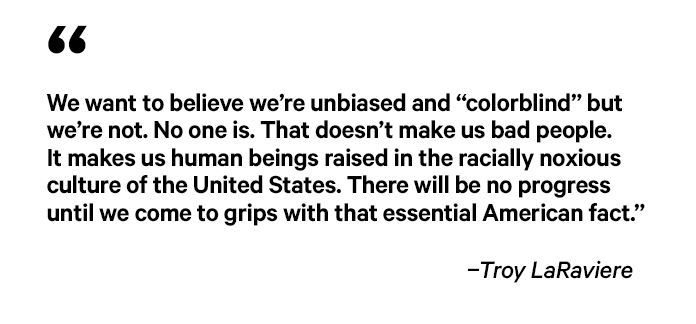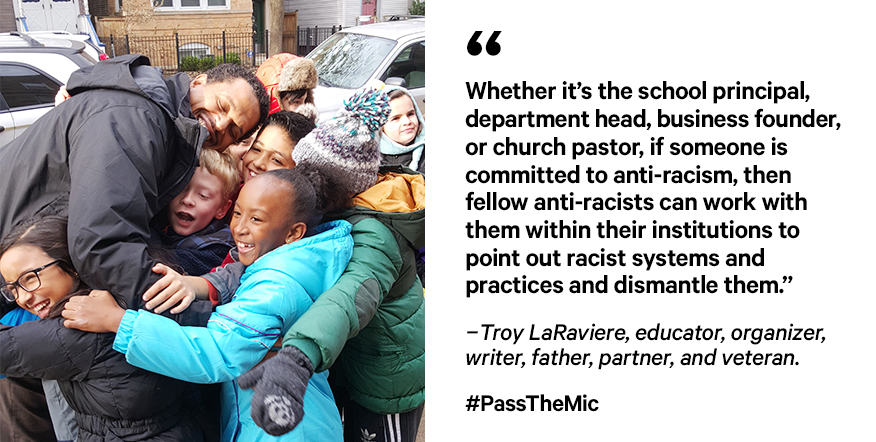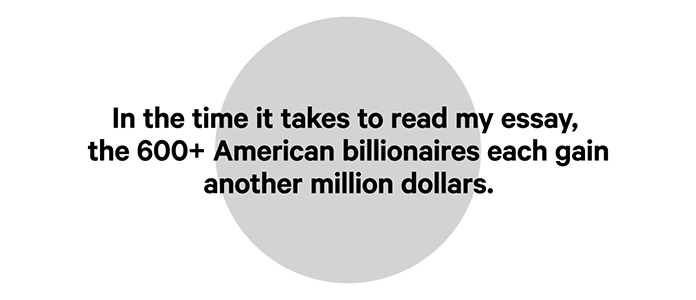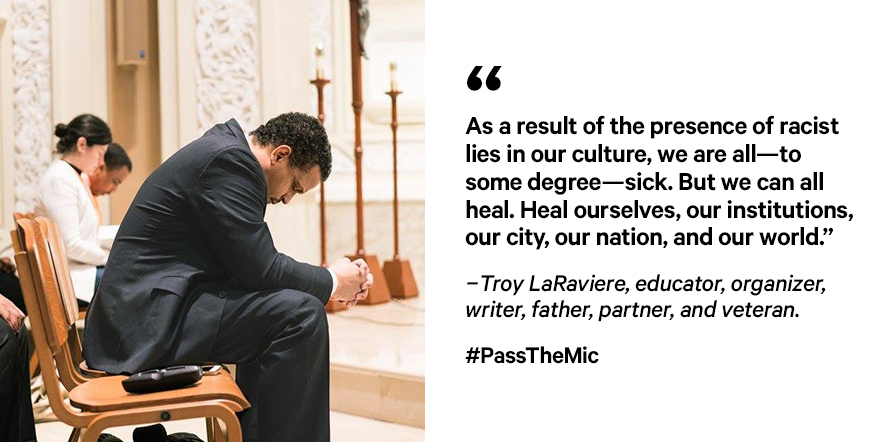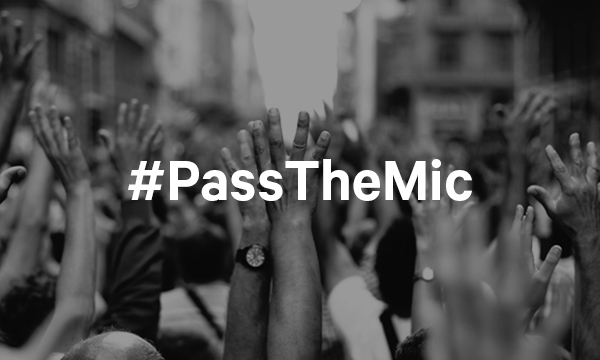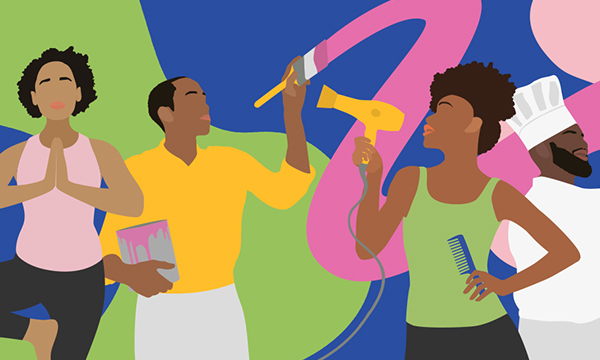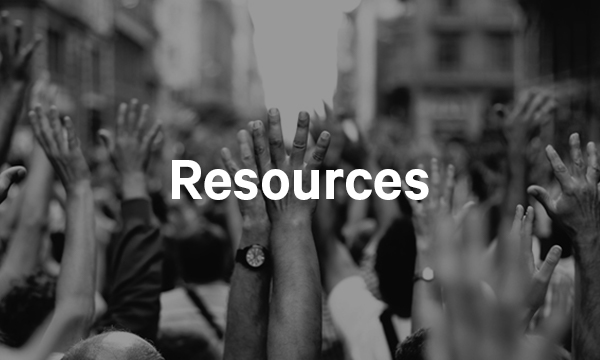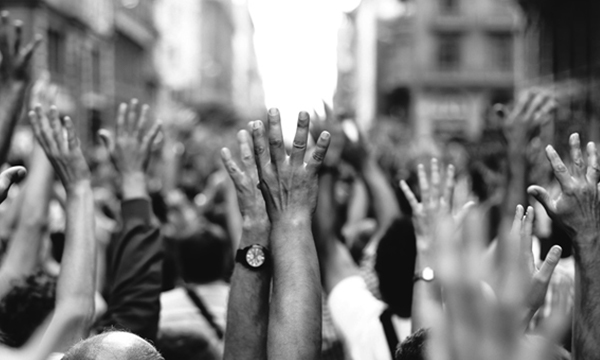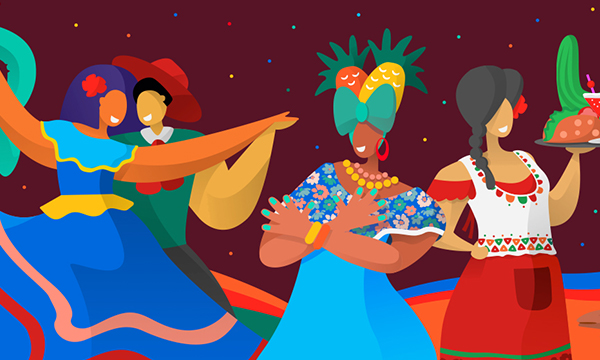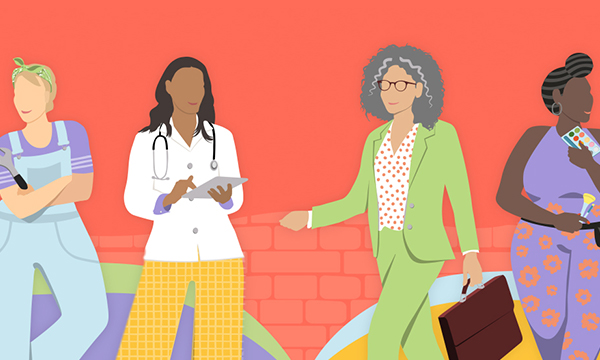#PassTheMic with Troy LaRaviere: A Course on Dismantling Racism
#PassTheMic is Groupon’s social media initiative that amplifies the voices of leaders in Black communities and allies for change. Mr. LaRaviere is taking over Groupon’s social media accounts for three days to teach a tweet-by-tweet and post-by-post mini-course on Dismantling Racism, with the course culminating on Juneteenth. An excerpted version of his course is available through social media. This page features the complete course.
About Troy LaRaviere
Troy LaRaviere is a relentless advocate for public policies and investments aimed at realizing all human potential. He was the principal of Blaine Elementary, Chicago’s #1 ranked neighborhood school (2016), and Chicago’s most awarded principal (2013 - 2015). He is in his second term as President of the Chicago Principals and Administrators Association; a post he was elected to in 2016.
Overview
Hello Beautiful People! Thanks and appreciation to Groupon for making their space available for this important learning opportunity. Please watch the welcome and overview video:
This is the beginning of a three-day course on dismantling racism. This lesson plan is free for anyone to use, whether you use this mini-course to educate yourself or others.
- Day 1: The Origins and Purpose of Racism
- Day 2: Types of Racism and How They Function
View Lessons
Lesson 1: Types of Racism and How They Function
Lesson 2: Anti-Black Prejudices at the Heart of Conditioned Racism
Lesson 3: Understanding Implicit Bias
Lesson 4: Institutional Racism & the CounterIntelligence Program
Day 2 Conclusion - Day 3: Dismantling Racism
View Lessons
Lesson 1: How To Dismantle Racism
Lesson 2: Prejudice Is An Illness That Can Be Treated and Healed
Day 3 Conclusion - Excerpts from Readings on Organizing
- Musical Coda
The course is designed to help people understand the three things that will dismantle racism:
- Confronting our own biases
- Transforming institutionally racist systems into anti-racist systems
- Uniting as working people to overcome the obstacles to our mutual prosperity
What is Juneteenth?
Friday is Juneteenth which commemorates, June 19, 1865, when a Union General arrived in Galveston, Texas to announce the end of slavery—more than two years after the President Lincoln’s Emancipation Proclamation was issued. Their two-year wait for emancipation means that Juneteenth is as much about the delay of freedom as it is about freedom itself.
Today, more than 157 years after Lincoln’s Proclamation, the full freedom of Black people is still delayed. This three-day course on dismantling racism concludes on Juneteenth, and I will use it to help people understand and dismantle the root causes of the delay of our freedom: Racism and the unmitigated greed that produced it. Today's lesson is on The Origins and Purpose of Racism.
Your learning goal for today is to be able to explain the origins of racism, the purpose it serves, and who it was designed to benefit.
Day 1: The Origins and Purpose of Racism
Lesson 1: Read and Analyze Part One of "Dismantling" Essay
Our 1st lesson activity is to read “Dismantling American Racism: Part 1.”
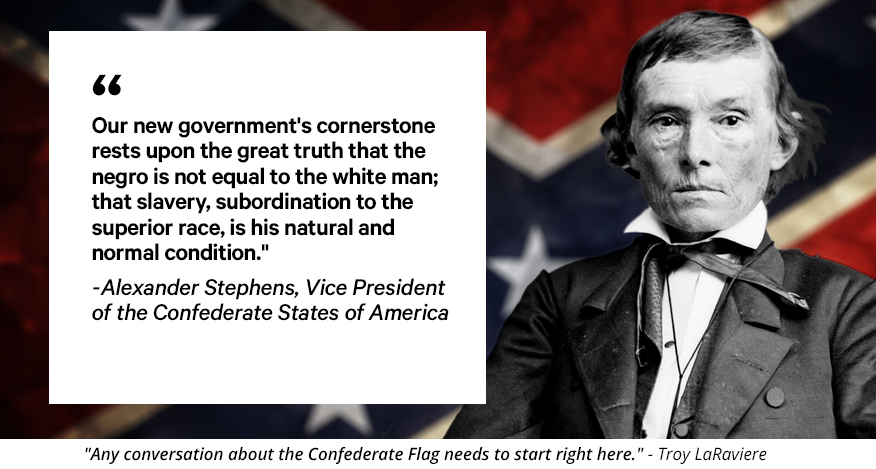
The desire of wealthy colonists to create a more stable and permanent workforce by intensifying the subjugation and enslavement of African laborers led them to develop the idea of color-based race and concomitant racist ideas to justify enslaving them.
Racism is not natural. Racist ideas were concocted to justify the absolute exploitation of African people and pit European workers against them, which facilitated the exploitation of both groups, one far more brutal than the other. A function of segregation is to reduce the likelihood that white people will have enough experiences with Black people to contradict the false narratives they’ve been conditioned to believe about them. Segregation is designed to reinforce and maintain the racially biased conditioning of American minds. In other words, segregation creates a physical oblivion to buttress and maintain a psychological oblivion.
Black people hold many of the same negative ideas about other Black people that many whites hold, because we grow and develop exposed to the same false noxious images and narratives about people who look like us.
Listening Exercises
Listen to Malcolm X discuss the conditioning of Black people to hold negative ideas about ourselves, asking his audience, “Who taught you to hate yourself?”.
Listen to ML King discuss the conditioning of Black people to hold negative ideas about ourselves. He calls it “cultural homicide” 31:46 to 36:00.
Key Points
"We must stand up amid a system that still oppresses us and develop an unassailable and majestic sense of values. We must no longer be ashamed of being black. The job of arousing manhood within a people that have been taught for so many centuries that they are nobody is not easy. [31:49]. … Even semantics have conspired to make that which is black seem ugly and degrading. A white lie is better than a black lie. The most degenerate member of a family is the "black sheep.” [32:04] … Maybe the English language should be reconstructed so that teachers will not be forced to teach the Negro child to despise himself, & thereby perpetuate his false sense of inferiority, & the white child to adore himself, and thereby perpetuate his false sense of superiority. [32:58] … The tendency to ignore the Negro's contribution to American life and strip him of his personhood is as old as the earliest history books and as contemporary as the morning's newspaper. [33:31] … Yes, we must stand up and say, "I'm black and beautiful." This self-affirmation is the black man's need, made compelling by the white man's crimes against him. [34:57]"
— Dr. Martin Luther King, Jr.
The concoction of racist or denigrating ideas to justify the inequitable treatment of targeted groups and pit them against one another has evolved uninterrupted for nearly 400 years. Black people have been the primary targets of such ideas, but far from the only targets.
Lesson 2: 2018 MLK Day Address
Listen to Part 1 of my 2018 MLK-Day Speech.
If this part of Martin Luther King’s speech at the end of the Selma to Montgomery March was played as much as I Have a Dream, we might have a different world.
In this speech, he was making the point that after slavery there was no segregation, black people could vote, and the Populist Movement was uniting poor whites and Blacks in a movement that could drive the wealthy from power. Segregation was created to stop this movement.
MLK said racist ideas were intensified after slavery to put the minds of poor white people in “psychological oblivion.” American elites made it a national pastime for whites to impugn the integrity of “black” character, question the truth of “black” voices, malign the intentions of “black” hearts, and trivialize the worth of “black” lives.
Listen to Part 2 of my 2018 MLK-Day Speech.
In order to saturate people’s thinking with the lie of white supremacy, American elites saturated their thinking with the lie of Black inferiority. Slavery ended but our nation’s leaders did not end the racist anti-Black culture they spent centuries creating to justify the subjugation of Black people. Our racial biases come from our constant exposure to racist images and narratives. In other words, we have been mind-f***ed.
Lesson 3: King’s Address at the Conclusion of the Selma/Montgomery March
Read the 9th through 13th paragraphs of MLK’s Selma/Montgomery Address. Some of the most important words ever spoken about racism as a tool of the wealthy. Or you can listen to the six-minute section of the speech (9:19 p to 15:12).
Key Points
We are exposing the very origin—the root cause—of racial segregation... Racial segregation as a way of life did not come about as a natural result of hatred between the races... Segregation was a political strategy employed by the Bourbon interests in the South to keep the southern masses divided and southern labor the cheapest in the land. … In response to a multi-racial 19th-century Populist Movement that threatened to drive the wealthy from power, they engineered a segregated society and "saturated the thinking of the poor white masses" with the doctrine of white supremacy. … Segregation stopped Negro & white masses from building a voting bloc. They segregated southern money from poor whites; southern mores from rich whites; southern churches from Christianity; southern minds from honest thinking; & they segregated the Negro from everything. … If it may be said of the slavery era that the white man took the world and gave the Negro Jesus, then it may be said of the Reconstruction era that the southern aristocracy took the world and gave the poor white man Jim Crow. … When poor white men’s stomachs longed for the food their empty pockets could not provide, they ate Jim Crow; a psychological bird that told them that no matter how bad off they were, at least they were white men, better than Black men. … That’s what happened when the Negro and white masses threatened to unite and build a great society of justice where none would prey upon the weakness of others; where greed and poverty would be done away; and where every man would respect the dignity and worth of human personality. … Racist ideas have put the minds of some white people in a “psychological oblivion.”
—Dr. Martin Luther King, Jr.
This speech is important because it shows that King was among the first major leaders to describe racism as more than just the result of bigotry and hate, but as a strategy employed to stop working people from getting compensated fairly by pitting them against one another.
Lesson 4: Stamped from the Beginning
This lesson is built with excerpts from Stamped from the Beginning: A Definitive History of Racist Ideas in America by Dr. Ibram X. Kendi. This thread focused on excerpts related to the origin of racism. Buy the book to read, or listen free on Spotify.
The Cause of Racism: Hatred & Ignorance or Greed & Self Interest?
“All in all, ethnic and religious and color prejudice existed in the ancient world. Constructions of races—White Europe, Black Africa, for instance—did not, and therefore racist ideas did not. … [Colonial] planters responded to labor demands and laborers’ unity by purchasing more African people and luring Whiteness away from Blackness. … The principal function of racist ideas in American history has been the suppression of resistance to racial discrimination and its resulting racial disparities.”
“[In the 1700's] newspaper reports of rape constructed white defendants as individual offenders and black defendants as representative of their failings of their racial group. Already, the American mind was consumed with racist ideas: individualizing White negativity and generalizing Black negativity … Consumers of these racist ideas have been led to believe there is something wrong with Black people, and not the policies that have enslaved, oppressed, and confined so many Black people.”
“[The idea that ignorance and hate lead to racist ideas, which lead to racist policies is a] false construction of the race problem. In fact, self-interest leads to racist policies, which lead to racist ideas leading to all the ignorance and hate. … [R]acist ideas usually did not dictate the decisions of the most powerful Americans when they instituted discriminatory policies against millions of Black lives. Racially discriminatory policies have usually sprung from economic, political, and cultural self-interests”.
The Origins of Racist Ideas
“Hate and ignorance have not driven the history of racist ideas in America. Racist policies have driven the history of racist ideas in America. And this fact becomes apparent when we examine the causes behind, not the consumption of racist ideas, but the production of racist ideas ... Time and again, racist ideas have not been cooked up from the pot of ignorance and hate. Time and again, powerful and brilliant men and women produced racist ideas to justify the racist policies of their era, and redirect the blame for racial disparities away from those policies and onto Black people...
“To think as an antiracist is to think there is nothing wrong with Black people, to think that racial groups are equal. When you truly believe that the racial groups are equal, then you also believe that racial disparities must be the result of racial discrimination … ‘When men oppress their fellow-men, the oppressor ever finds, in the character of the oppressed, a full justification for his oppression.’ [With this, Frederick] Douglass, amazingly, summed up the history of racist ideas in a single sentence.”
Day 1 Conclusion
As we approach Juneteenth and the delay in freedom that it symbolizes, let’s remember that we are still in the midst of that delay and that we must understand and fight its cause: Racism created by the greed and self-interest of the ruling class.
Day 1 Quiz
If teaching this curriculum, include the following quiz at the end of your lesson.
1. Today's lesson was about:
- How to dismantle racism
- The origin and purpose of racism
- The structure and function of racism
2. Racist policies were implemented to benefit
- Wealthy ruling class white men
- All white people
- Working white people
3. According to the historical record, racist ideas were PRODUCED because of:
- Greed and Self-Interest
- Hatred and Fear
- Ignorance and Prejudice
4. This man asked a Black audience, “Who taught you to hate yourself?”
- Malcolm X
- Martin Luther King, Jr.
- Frederick Douglass
5. This man told a Black audience that they’d been the victims of cultural homicide because they’d been taught for centuries that they were nobody.
- Malcolm X
- Martin Luther King, Jr.
- Frederick Douglass
6. The core idea behind white supremacy is:
- Christian exceptionalism
- Male supremacy
- Black inferiority
7. This movement in the late 1800s understood that Blacks and whites were both being fleeced by the wealthy, and it sought to unite them.
- The Civil Rights Movement
- The Suffrage Movement
- The Populist Movement
8. Martin Luther King, Jr. said this system was created--in part--to give comfort to poor white people who were being exploited by wealthy whites.
- Jim Crow Segregation
- Sharecropping
- Poll Taxes
9. Choose the correct causal chain
- Ignorance led to hatred, which led to racist ideas that led to racist practices
- Self-Interest led to racist practices, which led to racist ideas that led to ignorance and hate
- Racist ideas led to ignorance and hate that led racist practices
10. Racist ideas __________ white negative behavior while __________ Black negative behavior.
- Generalize, Individualizing
- Individualize, Generalizing
- Reject, accepting
11. This man said, in essence, whenever men want to exploit other men, they invent racist ideas to justify that exploitation.
- Malcolm X
- Martin Luther King, Jr.
- Frederick Douglass
Day 2: Types of Racism and How They Function
The content of this lesson is built out from Part 2 of my 3-part essay “Dismantling American Racism.”
Lesson 1: Types of Racism and How They Function
There are three distinct types of racism. Original Racism, Conditioned Racism (with two subtypes: Implicit Racism and Puppet Racism), and Institutional Racism.
Original Racism
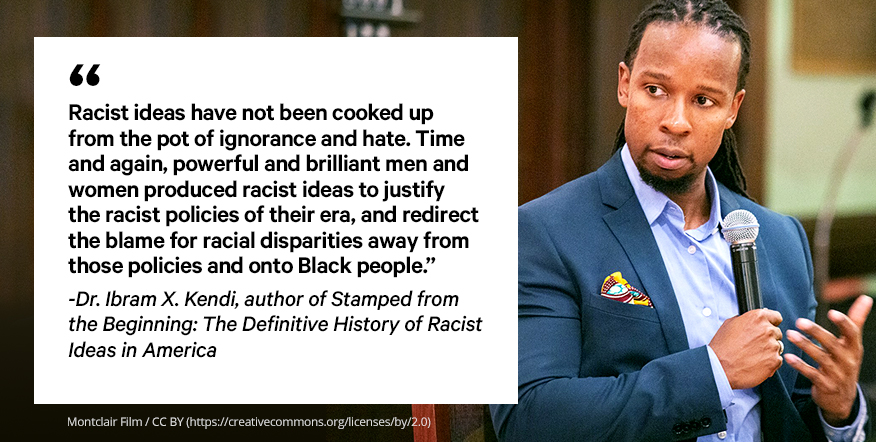
Conditioned Racism
When working people either consciously or subconsciously adopt and act on the racist ideas promoted by the ruling class — with or without realizing it — I call this Conditioned Racism. There are two subclasses of Conditioned Racism: Implicit Racism and Puppet Racism.
Human brains are not naturally racist, but our brains do function in a way that makes it possible for us to be manipulated into being racist. This is because our brains have a natural tendency to look for patterns and then create associations that simplify the world for us. We are overexposed to nefarious depictions of people of color--Black people in particular--in television, film, news, social and familial groups. Our brains then make subconscious associations between Black people and the behaviors they are repeatedly portrayed as exhibiting.
Implicit Racism
The subconscious beliefs behind implicit racism are referred to as implicit bias, and we can hold these biases even if we strive to be fair-minded people who believe in equity and equality because we adopt these biases without realizing it. There is a logical connection between bias and racism. Racial bias consists of implicit or explicit prejudices or ASSUMPTIONS about members of a racial group. Racism occurs when a person ACTS on those assumptions.
How Racial Biases Produce Racist Actions
| RACIAL BIAS | RACISM | |
| EXAMPLE 1 | A teacher feels as if Black students won't succeed if given challenging work | The teacher fails to give challenging work to those students |
| EXAMPLE 2 | A mayor believes the majority of African American students won't amount to anything | He shuts down dozens of their schools |
| EXAMPLE 3 | An officer feels as if a Black person is a danger to him without good reason | The officer shoots that Black person |
You will likely experience bias as your "gut," or your instincts. But we must come to realize that our guts have been hijacked and our instincts manipulated by a lifetime of slanted imagery, one-sided narratives, and segregation from the targets of the war on our minds.
Puppet Racism
Millions of Americans consciously consume and adopt racist ideas created by the ruling class. I call this PUPPET RACISM because (1) that name implies a source and (2) the puppet racists give voice to ideas produced by forces outside of themselves. What happens when you take racially conditioned and segregated minds and give them the responsibility of managing the education of Black children, interviewing Black job candidates, providing health services to Black people, or policing Black communities? It is important that we see racism as an act rather than just a belief because racism has an impact. It does more than insult and denigrate. It does measurable and immeasurable damage to human beings.
Institutional Racism
The damage done by racism is magnified a thousandfold when racist acts are sponsored, facilitated, and executed by the powerful systems and structures of public government and private business. This is known as Institutional Racism.
Whether it be racist sentencing laws, racist mortgage lending practices, racist school funding systems, or racist counterintelligence activities, private and public institutions exponentially increase the power of racism and the damage that it does to people.
Putting a Black person in a position of authority over a racist institution does not remove the racism. Some enslaved Africans toiled under Black overseers and Black slave drivers. The presence of Black overseers didn't make the enslavement of Black people any less racist.
Lesson 2: Anti-Black Prejudices at the Heart of Conditioned Racism
Let me use an encounter I had with a Chicago Police Officer to highlight anti-Black prejudices at the heart of conditioned racism. Watch or read below:
I was driving home after work in a hurry to see my three-year-old son, and—I admit—I may have run a few orange lights. From out of nowhere, a blue police truck zoomed up from behind me and cut me off. The officer burst out of his car, flashed his badge, flashed the gun on his hip, and charged towards my window. I looked into his eyes and said, “A gun!? For a traffic light!?” The officer lunged into my car, pulled out the keys, and began berating me.
Now I had a suit on—I was an Assistant Principal at the time. I looked in the rearview mirror and saw traffic backed up. And I said, “Officer, is it ok if I pull to the side so these folks can get by?”
He stopped.
And his eyes met mine.
And he said… “I’m sorry. You’re not who I thought you were.”
Who did he think I was?
“You’ve got a suit on. You’re conscientious of the people behind you. You’re not who I thought you were.”
Who did he think I was?
He thought I was exactly who America's racist culture had trained him to think I’ve been my entire life. And that training didn’t start in our police department. It started in our American culture.
Here’s another clip detailing my personal encounters with the police:
- In 1986, I was punched in the gut and walked over by a half dozen policemen at the Chicago Bears Super Bowl victory parade.
- In 1987, on the way to the Rainbow Roller Rink, I was stopped by a police officer along with several of my friends. And with a gun to my head, I was told never to bring myself back to the Northside and “to go back where we belong.”
- In 1991, I was arrested for using profanity. And the officer who arrested me, when he got me to the station, listened to me speaking and said “Oh, you’re one of those Black revolutionaries. You all want a revolution? I can’t wait till you have your revolution. Because that’s the day when I’m get to shoot all of you down.”
Think about that cop that followed me and my friends around and stopped us and put the gun to my head and said “don’t come back here.” What do you think he saw when he saw us driving?
He saw a bunch of kids who he’d been conditioned to think will probably be robbing somebody tonight.
He saw the same thing George Zimmerman saw in Trayvon Martin.
While we should be angry at George Zimmerman for what he did to Trayvon Martin, we have to be even more angry at a society and a culture that produces thousands of George Zimmermans every single day.
Lesson 3: Understanding Implicit Bias

The episode starts with a woman who had a brain condition that led one of her hands to act on its own without her conscious control of it. This was introduced as a metaphor for how ideas in our culture can influence us and our behavior without us being aware of it.
Frank met his inner racist in downtown Oakland after getting suspicious of a Black man walking toward a white woman at a bus stop. "I was disgusted with myself. I [acted with bias] just a couple weeks after telling my [adopted Black] daughter that people might do that [to her].
Suddenly it hit him. He had just done the very thing he feared would haunt his daughter’s life. He’d judged based on skin color. Implicit bias was hiding inside him.
All of us have ideas in our head implanted by our culture. They shape our actions. Sometimes those ideas undermine the type of person we want to be and run counter to the kind of world we want to build. This episode features a scientific experiment in which people said they weren’t prejudiced but behaved with prejudice when put in situations where they had to make decisions in regard to people of different races. It also tells the story of the scientist who developed the concept of implicit bias and a test to measure that bias, along with a study of doctors who exhibited implicit bias. The doctors didn’t realize it. Their Black patients did.
The way we learn anything is by repeatedly associating one concept with another. The more you encounter these concepts together, the stronger the connection. In America, the concepts of Black men and criminality are linked out of proportion to the degree to which they exist. Our culture has spent a lot of time teaching us to connect the concepts of Black men and criminality so they often are connected in our minds. Each time the association is activated, the stereotype or bias is strengthened.
St. Louis Police Lt. Ray Rice said, “Being a Black person I thought, ‘I can’t have an implicit bias toward Black people. That’s not even a thing.’” He didn’t pay attention during bias training until he heard the trainer utter the phrase, “Even well-intentioned people have implicit bias.”
As Lt. Rice listened to training on how people express unconscious bias, he remembered a time when he assumed the worst of a Black man at a gas station until he heard the man talking about helping a kid at his church. That assumption was his own implicit bias.
I was doing the same thing that was done to me” Rice said, referring to the times he had been racially profiled by police. He had made those kinds of assumptions and acted on them as a police officer. “It made me realize that if I was doing it, we got a lot of work to do.”
Listening to these stories is important because they provide examples of the process that you and I must go through to snuff out American racism, which is to recognize the root of that racism in ourselves.
Lesson 4: Institutional Racism & the CounterIntelligence Program
One of the most heinous, far-reaching, and consequential examples of Institutional Racism in modern times is The CounterIntelligence Program.
In 1971, white activists broke into an FBI office, and seized thousands of documents. This led to the discovery of one of the most brazen systems of government-sponsored institutional racism in the 20th Century. Watch:
Historical evidence shows parts of the federal government systematically sabotaged and destroyed Black efforts at political and economic self-sufficiency throughout the 20th Century. Watch:
Let’s highlight specific examples.
Yes. The FBI really did write a letter to Martin Luther King, Jr. in an attempt to get him to commit suicide. Read the letter for yourself:
And In Media, Pennsylvania, for example, you didn’t even have to have radical ideas or engage in violence to merit surveillance.
Historically, parts of our federal government—in cooperation with local police in every major city—have infiltrated, discredited, sabotaged, and destroyed nearly every effort of Black people to overcome the political and economic discrimination they faced in America.
Now pause.
And consider this…
Those systems of suppressing Black uplift efforts remain in place today.
Day 2 Conclusion
The power generated by individual and institutional racism makes it virtually impossible for people to thrive without dismantling that racism. It is toward that goal that I offer Part Three of this series.
Day 3: Dismantling Racism
The content of this lesson is built out from Part 3 of my 3-part essay “Dismantling American Racism,” which addresses the process for dismantling the three forms of racism we learned about in Day 2, Lesson 1.
Lesson 1: How To Dismantle Racism
Becoming An Anti-Racist
Racism is an individual or institutional act that leads to racial inequities and does mental, physical, political, or economic harm to members of a racialized group. Racism is either justified by, or triggered by, an idea that regards one race as inferior to another, in any way. To become anti-racist is to understand racism, and use your understanding of racism as the basis of the action you must take to dismantle it. If there are three forms of racism, then there will at least be three strategies to dismantle it. We will cover those in this lesson.
But we cannot get individual people to reject and correct their own racist biases if we can’t get them to first acknowledge that they hold these biases. I compare it to alcoholism. The first step toward treating alcoholics is to get them to acknowledge they are, indeed, alcoholics. We want to believe we’re unbiased and “colorblind” but we’re not. No one is. That doesn’t make us bad people. It makes us human beings raised in the racially noxious culture of the United States. There will be no progress until we come to grips with that essential American fact.
One may be actively racist by perpetuating racial prejudice and discrimination against non-white people. Or one may be passively racist by failing to notice racial bias in oneself or others and thus failing to address it. When good, well-meaning people realize they hold racial biases, they undergo the process that you and I must go through to snuff out American racism. That process is to recognize the root of that racism in ourselves, and to work to become an anti-racist.
Anti-racists monitor the thinking and programmed “gut” reactions they have to Black folks and other nonwhite people, whose personhood has been denigrated in our culture. Anti-racists identify, confront, and dismantle those racist ideas and biases in themselves and others.
Dismantling Institutional Racism
We learned about implicit bias in Day 2, Lesson 3. But when it comes to treating racism, implicit bias training is not enough. We must recognize and confront the source of our bias. We must be conscious of the fact that bias is the result of a virus spread by an adversary. That adversary, though small in number, has access to immense institutional power.
Whether it's the school principal, department head, business founder, or church pastor, if someone is committed to anti-racism, then fellow anti-racists can work with them within their institutions to point out racist systems and practices and dismantle them.
Whether an institution is actively or passively racist, the strategy for changing it is — for the most part —the same. Changing institutions requires influence and power. So we must study and master the tactics people have used to gain influence or power.
The Three Sources of Power for a Group of People
- The ability to grow: to pool human, material, and monetary resources.
- The ability to strengthen connections: this includes those within our group (internal relationships) and those outside of it (external relationships). Strengthening connections builds trust and strong allies in our push for change.
- The ability to strategize: to set common goals & develop intelligent plans that turn what we have (numbers, resources and relationships) into what we need (intelligently designed collective action) to get what we want (specific changes).
Our goals must be specific so that we know what a win looks like. We cannot accept diversionary tactics like "equity frameworks" or "task forces.” These do not root out systems, policies, and practices that create or sustain racial inequity.
Dr. King understood the need to achieve justice through building power. Watch (37:17 to 39:30):
Key Points
“Another basic challenge is to discover how to organize our strength into economic and political power… Now power, properly understood, is nothing but the ability to achieve purpose … It is the strength required to bring about social, political, and economic change. One of the great problems of history is that love and power have usually been contrasted as polar opposites … Now we’ve got to get this thing right. What is needed is a realization that power without love is reckless and abusive and that love without power is sentimental and anemic.”
Uniting Working People Against a Common Adversary
The ultimate goal of an anti-racist must be to unite working people in identifying, targeting, and confronting wealthy business and political interests that produce and uphold racist ideas.
Since the goal of producing racist ideas is to pit working people against one another—and to keep working people from getting a fair share of the public and private wealth that we produce—then anti-racist work must ensure that we all fight together to reap the full benefits of that wealth.
In essence, we must broaden our anti-racist work into a larger struggle. This will enable us to achieve the very thing that racism was designed to prevent: shared prosperity for all people through an equitable share of the public and private wealth that working people produce. Racism destroys people's ability to realize their individual and collective human potential. In dismantling racism, we achieve even greater goals. We not only realize our individual potential. We share the exponentially beneficial impact it will have on all our lives.
In the time it takes to read through this lesson, the 600+ American billionaires each gain another million dollars.
Do they do a million dollars worth of work in that amount of time?
No.
Regular people like you and I do that work.
But we do not get a fair share of the wealth we produce.
Under American racism, a white person typically makes more than a similarly situated Black person. But both would build more wealth if we joined together to compel our nation to compensate workers in accordance with the value of the public and private wealth our labor produces. White puppet racists must come to terms with the fact they have been duped, hoodwinked, and bamboozled into identifying more with their ruling class adversaries than with their logical allies: working-class people of color.
All working-class people must realize that not only is it morally and ethically right to recognize and reject prejudices and racist ideas. It is in their best interests.The wealthy business interests who dominate politics in our country did not amass wealth and power by basing their decisions on altruistic considerations. They amassed wealth and power because their decisions are based on their own self-interest.
Unjust systems don’t change because the powerful become enlightened.Unjust systems change when common people use petitions, strikes, occupations, boycotts, demonstrations, and rebellions to make it in the self-interest of the powerful to change and relinquish their power.
Lesson 2: Prejudice Is An Illness That Can Be Treated and Healed
We must educate people to be anti-racist. We must train people to reject their prejudices more often than they succumb to them. Prejudice becomes racism when we act on it. Dr. King understood that prejudice is not an evil.
Dr. King referred to potential assailants as “our sick white brothers,” not our “evil” white brothers. He understood: Prejudice is an illness that can be treated and healed.
Day 3 Conclusion
As a result of the presence of racist lies in our culture, we are all—to some degree—sick. But we can all heal. Heal ourselves, our institutions, our city, our nation, and our world.
Excerpts from Readings on Organizing
Before we conclude this course, I’d like to highlight quotes from texts written by people experienced with organizing for power. They are Jane McAlevey, Marshall Ganz, Edward Chambers, and civil rights scholar, Aldon Morris.
Aldon Morris
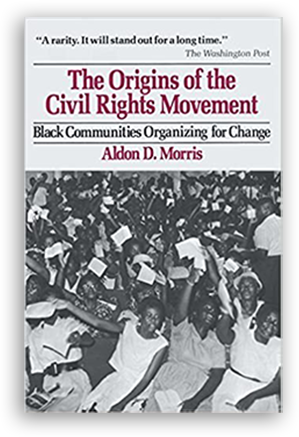
“Organizing and planning were central to all [local civil rights movement successes]. These movements spread through sophisticated preexisting formal and informal communication networks.”
“Preexisting social organization and communication networks were crucial to the [Civil Rights] movement’s development. It was these forms of social organization that made widespread mobilization possible.”
Jane McAlevey
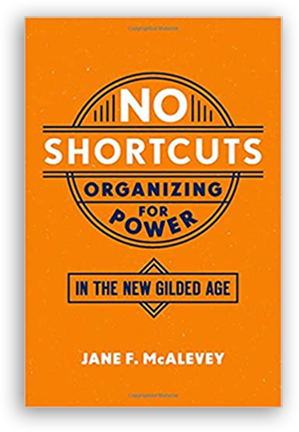
“Progressives have had a four-decade decline because of a long-term shift away from deep organizing toward shallow mobilizing. Workers as the primary leverage of their own salvation have been replaced by the corporate campaign which takes away from the rank and file.”
“The chief factor in whether organizational efforts grow into effective movements is where the agency for change rests. It must rest with an expanding base of ordinary people who make the power analysis, design the strategy, & achieve the outcome. They are essential and they know it.
“Unions must see their members’ organic ties to their communities strategically. Their organic ties to the broader community form the potential strategic wedge needed to leverage the kind of power American workers haven’t had for decades.”
Edward Chambers

“Public conversation and collaborative action by organized citizens remains our best hope for dealing with the challenges before us. Organizing is about more than winning on issues—it is about developing people’s potential to realize their hopes.”
“At its best political organizing creates and sustains social relationships.”
“Organizing work must be done in collectives. Sharing concerns through relational meetings, house meetings, assemblies, and councils for deliberation must happen. The accountability of elected officials to organized people instead of organized money is at the heart of all this.”
Marshall Ganz
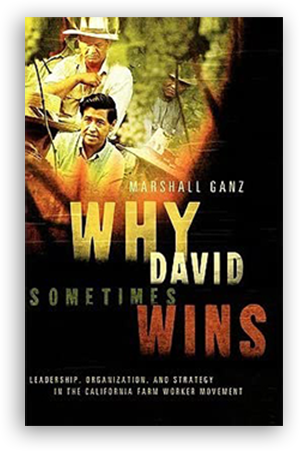
“Strategy is how we turn what we have into what we need, to get what we want. It is shaping present resources toward future goals. We must mobilize & deploy our political, cultural, and economic resources to influence those who hold or control the resources we need.”
“More diverse social networks create access to a broad range of useful information & feedback. Regular strategic open deliberations create synergistic knowledge that lone leaders cannot. Motivation increases when people are acting on choices they had a hand in making.”
Musical Coda
To end our three-day mini-lesson on American Racism, I offer six songs that enable us to reflect on our world as it is, and conceive of our world as it should be. May we create that world together.
I Find It Hard to Say
by Lauren Hill
You think our lives are cheap & easy to be wasted
As history repeats so foul you can taste it
...
Repent, the day is far too spent, rebel, rebel
Wake up, wake up, wake up, wake up, wake up and rebel
Dweller on the Threshold
by Van Morrison
I’m a dweller on the threshold
I cross some burning ground
I'll go down to the water
Let the great illusion drown
I'll walk out of darkness
I'll walk into the light
I'll sing a song of ages
And the dawn will end the night
Black Man in a White World
by Michael Kiwanuka
I feel I've been here before
I feel knocking on my door
I feel like I've been here before
I feel that knocking on my door
I've lost everything I had
And I'm not angry and I'm not mad
I'm a black man in a white world
Amendment
by Ani DiFranco
Wouldn’t it be nice ...
To give civil rights to women...
I know you’re thinking...
Chicks got it good now
They can almost be president
But it's worker against worker
Time and time again
Cause the rich use certain issues as a tool
Old Jim Crow
Nina Simone
Old Jim Crow
You know it's true
When you hurt my brother
You hurt me too...
Old Jim Crow
I thought I had you beat
Now I see you walkin'
And talkin' up and down my street
Old Jim Crow don't you know
It's all over now
Sack Full of Dreams
by Donny Hathaway
I got a dream for the world
people with hearts that care
Can they learn, can they learn
Can they learn to understand
The world of love peace, peace, happiness
Love and kindness
This is my sack full of dreams
And now, I #PassTheMic. It has been an honor. Peace and Blessings Beautiful People.
—Troy LaRaviere
See What Troy LaRaviere Posted During His Takeover
Facebook Teaser; Day 1 Post 1 and Post 2; Day 2 Post 1 and Post 2; Day 3 Post 1 and Post 2
Instagram Teaser; Day 1 Post 1 and Post 2; Day 2 Post 1 and Post 2; Day 3 Post 1 and Post 2
Instagram Stories (coming soon)
Twitter Day 1 Thread 1, Thread 2, Thread 3, Thread 4, Thread 5; Day 2 Thread 1, Thread 2, Thread 3, Thread 4, Thread 5; Day 3 Thread 1, Thread 2, Thread 3, Thread 4, Thread 5
#PassTheMic with Troy LaRaviere: A Course on Dismantling Racism
Follow Troy LaRaviere on Medium, Instagram,and Twitter
Day 1 Quiz Answer Key: 1-B, 2-A, 3,A; 4-A, 5-B, 6-C, 7-C, 8-A, 9-B, 10-B, 11-C


